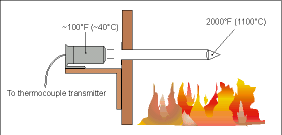Measuring high temperatures with immersion thermowells
November 2001
Analytical Instrumentation & Environmental Monitoring

Like ordinary thermocouples, the high temperature IRt/c models can be used with immersion thermowells to measure high temperature gases or liquids while maintaining the integrity of the vessel. However, the IRt/c has significant advantages over ordinary thermocouples, RTDs, etc in this application.
Survivability
Since the IRt/c sensor elements are positioned in a non-contact mode, outside of the heated area and kept at a low temperature, the entire temperature sensing system can be designed to survive for a much longer period of time than conventional thermocouples or RTDs. The only part requiring maintenance is the thermowell itself, an inexpensive and easily replaced part. Users enjoy savings because there are no replacement thermocouple parts, no replacement labour and no production losses from downtime for sensor replacement.
Sensor stability and 'drift'
Even worse than sensor failure is a sensor that reads incorrectly, feeding inconsistent or inaccurate information to the control systems. Sensor stability and drift can be significant problems with standard thermocouples when measuring high temperatures, due to chemical and metallurgical changes that long exposure to high temperatures causes. The IRt/c, however, is essentially immune to those effects, since the sensor remains at a low temperature - far below that of the contact device and below the high levels that are the major causes of drift.
Sensor speed
With its 0,1 to 0,2 s response time, the IRt/c is far faster than any conventional thermocouple or RTD placed inside a well. Accordingly, for all practical purposes, the temperature measurement speed is the same as that of the well itself.
How to use the IRt/c with a thermowell
The technique is to mount an IRt/c sensor so that it aims directly into a hollow thermowell. The well should have a minimum inner diameter to accommodate the minimum spot size of the sensor selected. It is important to choose an appropriate sensor for the temperature range and length of the well to be used. For example, to measure up to 1100°C, 2 m into a stack, An appropriate sensor would be the IRt/c.100A-HiE looking into a thermowell of that length with an inside diameter of at least 20 mm. The spot diameter for the IRt/c 100 A at 2 m is 20 mm. The sensor can then 'see' all the way into the hollow well tube and monitor the tip end temperature, ignoring the sidewall temperatures.
Thermowell material (stainless steel, Hastelloy, Inconel, ceramic, etc) needs to be chosen to withstand the temperature, oxidation and other rigours of the environment where it is to be placed.
If the thermowell is sealed with a sight glass, then a Lo E model should be specified.
Absolute Automation
(011) 453 6662
[email protected]
Further reading:
Ensuring clean and safe water
Endress+Hauser South Africa
Editor's Choice Analytical Instrumentation & Environmental Monitoring
Endress+Hauser’s comprehensive range of disinfection sensors is designed to monitor and control disinfectant levels in water treatment processes.
Read more...
High-precision measurement of insulating gases
WIKA Instruments
Analytical Instrumentation & Environmental Monitoring
WIKA has launched the next generation of its GA11 gas analyser. It enables switchgear operators, manufacturers and maintenance companies to record the quality of SF6 gas and alternative insulating gases.
Read more...
Say goodbye to missed contamination with real-time colour monitoring
Analytical Instrumentation & Environmental Monitoring
Applied Analytics offers seamless and rapid colour monitoring in processes with an industry-proven analyser that quickly and accurately monitors colour in your sample stream for impurities and inconsistencies.
Read more...
Metrology laboratory is the heart of data-driven production consistency
Analytical Instrumentation & Environmental Monitoring
Pressing and welding have been at the core of Tier 1 automotive supplier, Malben Engineering for 50 years; but it is the company’s investment in its state-of-the-art metrology laboratory which has set it apart.
Read more...
Unlocking precision: The future of inline concentration measurement
Analytical Instrumentation & Environmental Monitoring
[Sponsored] In today’s resource-conscious industrial world, manufacturers are under growing pressure to optimise productivity, ensure consistent product quality and minimise waste. One of the most effective levers for achieving these goals lies in mastering concentration measurement, and Anton Paar is redefining how it is done.
Read more...
High-precision measurement of insulating gases
WIKA Instruments
Analytical Instrumentation & Environmental Monitoring
WIKA has launched the next generation of its GA11 gas analyser. It enables switchgear operators, manufacturers and maintenance companies to record the quality of SF6 gas and alternative insulating gases.
Read more...
Smart sensors for cleaner, safer food and beverage processes
Instek Control
Analytical Instrumentation & Environmental Monitoring
Instek Control specialises in advanced measurement solutions tailored for the food, beverage, pharmaceutical and mining industries. Among the company’s offerings are advanced process sensors from Anderson-Negele, as well as ALVIM biofilm monitoring technology.
Read more...
Elevating mining separation processes through precision instrumentation
Endress+Hauser South Africa
Analytical Instrumentation & Environmental Monitoring
In mining operations, the quest for efficiency and productivity is key. There is an urgent need for innovative solutions to enhance the performance of extraction processes while balancing operational costs and environmental impact.
Read more...
Alfa Laval launches next generation
Analytical Instrumentation & Environmental Monitoring
Alfa Laval has launched Clariot, a next generation, AI-based condition monitoring solution, precision-built for hygienic process equipment to deliver more accurate analysis and support.
Read more...
The next generation in metal sorting
Mecosa
Analytical Instrumentation & Environmental Monitoring
In the metal recycling industry, companies are increasingly challenged to not only improve the efficiency of their processes but also to raise the quality and purity of the sorted materials to new levels. By integrating proven spectral analysis technology into its market-leading REDWAVE XRF sorting system, REDWAVE is unlocking new opportunities for metal recycling, particularly in aluminium recovery.
Read more...


